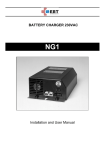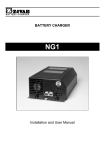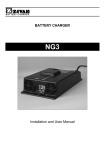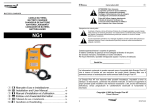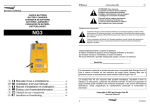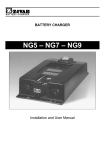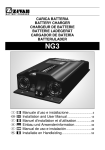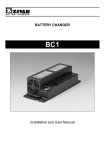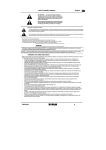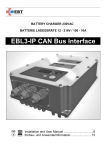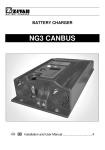Download Cantec Systems CHFC-3 User manual
Transcript
CHFC-3 Your Power Solutions Specialists HIGH FREQUENCY BATTERY CHARGER BATTERY CHARGER Installation and User Manual Battery charger CHFC-3 ATTENTION: To reduce the risk of electric shock, do not remove cover. Refer servicing to qualified service personnel. Disconnect the mains supply before connecting or disconnecting the links to the battery. Read the Instruction Manual carefully before use. Verify that the selected charge curve is suitable for the type of battery You have to re-charge. Explanation of Graphical Symbols The lightning flash with arrowhead symbol, within an equilateral triangle, is intended to alert the user to the presence of uninsulated “dangerous voltage” within the equipment’s enclosure; that may be of sufficient magnitude to constitute a risk of electric shock to persons. The exclamation point within an equilateral triangle is intended to alert the user to the presence of important operating and maintenance (servicing) instructions in the literature accompanying the equipment. This product is covered by warranty. The relative warranty certificate is attached to the Instructions Manual. If the Manual is not provided with this certificate, please ask your retailer for a copy. For further references, please write the serial number in the proper space: Serial No. _____________________ 2 Battery charger CHFC-3 Installation and safety instructions Battery charger CHFC-3 has been designed to provide safety and reliable. It is necessary to observe the following precautions in order to avoid damage to persons and to the battery charger: • Read the installation instructions contained in this Manual carefully. For further information put the Manual in a proper place. • Fix the battery charger to a stable surface through the appropriate holes inserted on the fixing flanges. In case of installation on a vehicle it is advisable to use antivibration supports. • Preferably the charger should be installed in the vertical position with fans facing up. The horizontal installation is allowed. Never install in the vertical position with fans facing down. • Ensure all ventilation ports are not obstructed, to avoid the overheating. Do not put the battery charger near heat sources. Make sure that free space around the battery charger is sufficient to provide adequate ventilation and an easy access to cables sockets. • Protect the battery charger from ingress of water. Do not pour liquids inside the case. • Verify that the available supply voltage corresponds to the voltage that is stated on the battery charger name plate. In case of doubt, consult a retailer or local Electric Supply Authority. • For safety and electromagnetic compatibility, the battery charger has a 3-prong plug as a safety feature, and it will only fit into an earthed outlet. If you can not plug it in, chances are you have an older, non-earthed outlet; contact an electrician to have the outlet replaced. Do not use an adapter to defeat the earthing. • To avoid damaging the power cord, do not put anything on it or place it where it will be walked on. If the cord becomes damaged or frayed, replace it immediately. • If you are using an extension cord or power strip, make sure that the total of the amperes required by all the equipment on the extension is less than the extension’s rating. • Disconnect the mains supply before connecting or disconnecting the links to the battery. • To recharge Lead Acid batteries: WARNING: Explosive Gas – Avoid flames and sparks. The battery must be positioned in a correctly cooled place. • Do not use to charge batteries installed on board of thermal engine cars. • Avoid recharging of non-rechargeable batteries. • Verify that the nominal voltage of the battery to be re-charged corresponds to the voltage stated on the battery charger name plate. • Verify that the selected charging curve is suitable for the type of battery to be re-charged. In case of doubt, consult Your retailer. ZIVAN S.r.l. will not accept any responsibility in case of mistaken choice of the charging curve that may cause irreversible damage to the battery. • In order to avoid voltage drop, thereby assuring 100% charge at the battery, the output cables must be as short as possible, and the diameter must be adequate for the output current. • In the case of thermal compensation of the battery voltage, it is necessary to place the thermal sensor in the area of highest battery temperature. • Do not try to service the battery charger yourself. Opening the cover may expose you to shocks or other hazards. • If the battery charger does not work correctly or if it has been damaged, unplugged it immediately from the supply socket and from the battery socket and contact a retailer. 3 Battery charger CHFC-3 Operating principle The battery charger considerably affects battery life and performances, which is the main part of every electric vehicle. A non controlled traditional battery charger (rectifier) provides a simple direct AC/DC conversion. Disadvantages of this solution are: • Low efficiency • Large physical size • Long charge times • Charge depends on changes in the mains supply (with overcharge danger in the final charge phase) i AC v Battery DC In modern battery chargers these disadvantages are solved with an indirect AC/DC conversion, by passing through an intermediate DC/DC conversion. This is the usual method of operation for the i SMPS (Switching Mode Power Supply) at high power. This solution gives a good DC AC performance for minimum costs and physical Battery v dimensions using switches more faster and DC DC powerful (modern technology). The main advantages of this solution are: • High efficiency • Reduced dimensions • Short charge times • Charge independent from the changes of the mains supply • Electronic control that provides the desired charge curve The advent of electrical problems (due to commutation) has imposed the introduction of adequate filtering to satisfy requirements of EMC 89/336/EEC directive for electromagnetic compatibility. Block Diagram L E N F1 F2 EMI FILTER RECTIFIER AND FILTER POWER RECTIFIER CONTROL AND FILTER LOGIC STAGE RECTIFIER AND FILTER EMI FILTER 4 Battery charger CHFC-3 LED Indicator 100% 80% 80% RED LED shows that the battery is in the initial charging phase. YELLOW LED shows that the battery charger has reached 80% of charge. GREEN LED shows that the battery has reached 100% of charge. START Further information can be found in the description of the Charging Curve. Example: RED LED on with brief blinks indicates a constant tension phase. Alarms (Two-tone audible message) An two-tone audible message and the flashing LED shows that an Alarm situation has occurred: Condition Alarm Type Audible message + Battery Presence Battery disconnected or not in conformity. (Verify the connection and the nominal voltage). Thermal Sensor The thermal sensor is disconnected during the recharge or it is out working range. (Verify the connection of the sensor and measure the temperature of the battery). Timeout Phase 1 and/or Phase 2 have a duration in excess of the maximal allowed. (Verify the battery capacity). Battery Current Loss of output Current control. (Failure of the control logic). Battery Voltage Loss of output Voltage control. (Battery disconnected or failure of the control logic). Selection An unavailable configuration has been selected (Verify the selector’s position) Thermal Overheating of semiconductors. (Verify the fan operation). RED flash Audible message + YELLOW flash Audible message + GREEN flash Audible message + RED-YELLOW flash Audible message + RED-GREEN flash Audible message + YELLOW -GREEN flash Audible message + RED-YELLOW-GREEN flash Description (Action) When there is an alarm the battery charger stops supplying current. Thermal Sensor and/or External Indicator Thermal Sensor and External Indicator are Options that have to be connected to the 5 poles socket 180°. Unless otherwise stated, the compensation of the Battery Voltage in function of the temperature of the Thermal Sensor is of -5mV/°C for battery cell. The control range of the Thermal Sensor goes from -20°C to +50°C. The External Indicator reflects exactly the LED Indicator which is placed on the equipment. Further information can be found in the description of the Charging Curve. 5 Battery charger CHFC-3 Auxiliary Contacts AUX1 NC C NO AUX2 NC C NO Technical Features: changeovers contacts 0,3A 125VAC 0,3A 110VDC 1A 30VDC Connector: faston 6,3 × 0,8 mm Unless otherwise stated, the auxiliary contacts provide the following functions: Section AUX1 Function Mains Presence AUX2 End of charge or Trickle Phase Description When the equipment is switched on, the contact Normally Open (NO) CLOSES and instead the contact Normally Closed (NC) OPENS. When the Stop Phase or the No Stop Phase is reached, the contact Normally Open (NO) CLOSES and instead the contact Normally Closed (NC) OPENS. LED Bar Graph 100% The LED Bar Graph is an Option that shows a percentage indication of output current in comparison with its max. value 50% CURRENT Battery A battery is characterised by two sizes: tension and capacity. Tension: Each element has a nominal tension, which depends on the type of battery (no matter what size). In order to reach higher tension, many elements are connected in series, so creating a “BATTERY” of elements. The number of elements is calculated by dividing the nominal tension of the battery for the tension of each single element in the table: Type Pb NiCd NiMH NiZn Nominal Tension 2 V/cell 1,2 V/cell 1,2 V/cell 1,714 V/cell Capacity: It is the quantity of electric charge that the batteries can supply to an external circuit before the tension decreases under the final limit value and it is obtained by multiplying the intensity of the discharging current I, expressed in ampere (A), for the discharging time t expressed in hours (h): C = I x t The traction battery capacity is normally referred to the discharging system of 5h: C5 = I x 5h. The capacity values that can be recharged by the battery chargers can be found in the description of the Charging Curve (this value is not present in the curves able to charge any capacity). : This device is in conformity with the Low Voltage directive 73/23/EEC and EMC directive 89/336/EEC and their further modifications. 6 Battery charger CHFC-3 Mechanical dimensions 370 220 90 78 6 430 N.B. All dimensions are expressed in mm. Drilling details 220 = = 18 6 UP Advised Installation 399 430 N.B. All dimensions are expressed in mm. 13 60 100 60 7 Battery charger CHFC-3 TECHNICAL FEATURES Ta=25°C unless otherwise specified Mains side Description Supply Voltage Frequency Absorbed Maximum Current Inrush Current Symbol Test Condition Value and/or Range Unit Vin - 230 ± 10% Veff f - 50 ÷ 60 Hz 20 Aeff Iinmax < 1,35 A cosϕ P = Pmax 0,68 - Absorbed Minimum Power Pinmin End of charge <5 W Absorbed Maximum Power Pinmax P = Pmax 3 kW Power Factor - P = Pmax Vin = 230Veff Battery side Description Symbol Test Condition Value and/or Range Unit Output current I - See curve - Maximum output current I1 Phase 1 See curve A Output current ripple - I = I1 < 5% - Absorbed current Ia Equipment turned off Output voltage U Constant output voltage U1 Thermal compensation of output voltage dU1/dT Operating range of Temperature Sensor ∆T Output voltage ripple Maximum power supplied Output capacity < 0,5 mA See curve - Phase 2 See curve V Phase 2 -5 mV / (°C·cell) from -20 °C - - to +50 Pmax C U = U1 < 1% - U = U1, I = I1 2550 W Depend on the model (>0,2) mF - 8 Battery charger CHFC-3 General Description Symbol Test Condition Value and/or Range Unit Operating range of temperature ∆T - from -20 to +50 °C Maximum relative humidity RH - 90% - Switching frequency fc - 30 ± 5% kHz Efficiency η > 85% - Maximum size At each operation condition a×b×c Without connecting cable 430×220×90 mm Weight - Without connecting cable 5,5 kg Enclosure class - IP20 - - Protection and Safety Description Symbol Test Condition Value and/or Range Unit Insulation - Mains to Battery side 1250 VAC Insulation - Mains side to Earth 500 VDC Insulation - Battery side to Earth 500 VDC Leakage current IL Supplied equipment <3 mA Input fuse F1 Inside the equipment 20 A Output fuse F2 Inside the equipment about 1,2×I1 A 1,5 V/cell See curve V Protection provided by fuse F2 - 100 °C Minimum output voltage of operation (Battery Detector) Maximum output voltage Um Equipment turn on Phase 3 (IUIa - IUIUo) Reverse output polarity - At the connection to the Battery Thermal protection of semiconductors (Temperature of Thermal Alarm) - Ta=55°C Safety Requirements (Rules) - EN60335-1, EN60335-2-29 - - EMC Requirements (Rules) - EN55014-1, EN61000-3-3 EN55014-2, EN61000-4-2 EN61000-4-4, EN61000-4-5 EN61000-4-6, EN61000-4-11 - - 1573 LAPERRIERE AVENUE OTTAWA ON 1Z 7T3 OTTAWA Tel: 613-725-3704 Fax: 613-725-0490 Your Power Solutions Specialists TORONTO: Tel: 613-725-3704 Fax: 613-725-0490 VANCOUVER: Tel: 604-736-4922 Fax: 604-736-1074 A DIVISION OF CANTEC REPRESENTATIVES









